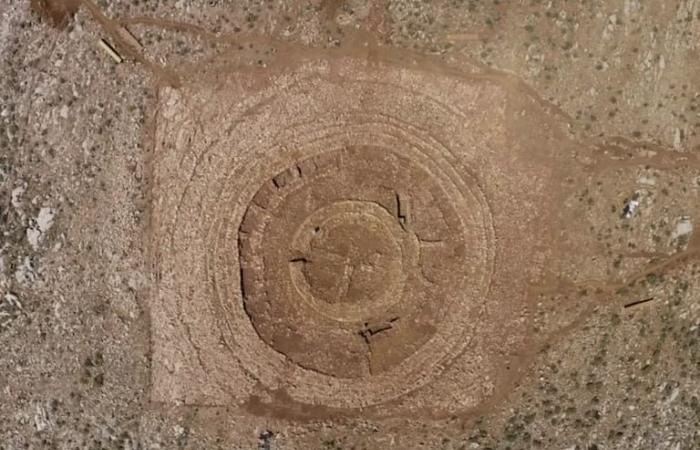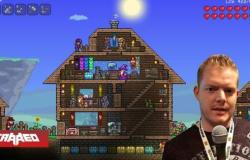
Hear
Jorge Luis Borges would be happy. This Tuesday, the Greek Ministry of Culture announced the discovery on the island of Crete of a “unique” building from the Minoan civilization. At the top of Papoura Hill, northwest of the town of Kastelli, a large circular structure dating from between 2000 and 1700 BC was discovered. It is located on the perimeter of the new international airport in Heraklion, the capital of Crete, which is under construction.
The building was found on the hill, about five hundred meters high, in a place initially reserved for the installation of a radar for the new airport. “It is a unique and especially interesting discovery,” declared Minister Lina Mendoni.which noted that it was the first find of its kind in Crete.
The ruins, as in Borges’ story, are circular and made of stone, and have an area of 1800 square meters. It contains eight “almost labyrinthine” rings connected by small openings and converging into a circular building in the center. The use of the structure is unknown, but according to archaeologists it could have had ritual functions, between 3,700 and 4,000 years ago, given that animal bones were found. The walls, built at different levels of altitude, have an average thickness of 1.40 meters and an estimated maximum height of 1.7 meters.
The new airport’s radar, of course, will be located elsewhere. “The airport construction work must continue unhindered, but this unique and exceptionally interesting find must also be protected. -said Mendoni-. We have carried out an analysis of the archaeological site and the priority of all parties is to protect this complex. “The new airport project can go ahead and the antiquities can be protected, as they should be.”
The Minoan civilization flourished on Crete and other islands in the Aegean Sea in the Bronze Age, and is considered one of the first on European territory. Crete is a “quarry” of archaeological sites; The ruins of the palace of Knossos and the palace of Phaistos have been found there. To these is now added this new labyrinthine construction.
The notion of labyrinth, so dear to Borges’ literature, arises from the Cretan mythology of the Minotaur, the creature with a human body and the head of a bull, son of Pasiphae and the bull of Poseidon. The Athenian architect Daedalus, taking refuge in Crete, built a labyrinth at the request of Minos to enclose the monster to which seven young men and seven maidens were periodically sacrificed who, once thrown into the labyrinth, could not escape.
Theseus, the Athenian prince in love with Ariadne, daughter of Minos and Pasiphae, is the one who manages to kill the Minotaur, using “Ariadne’s thread”, a ball of thread with which the hero avoids getting lost in the labyrinth. Daedalus had given this useful advice to his lover.
In the story “The House of Asterión”, Borges recreates the myth of the Minotaur created by the historian Apolodoro in mythological libraryand presents Asterion as a being waiting for a redeemer to put an end to his existence.
“Every nine years nine men enter the house so that I can free them from all evil,” reads the masterful Borgesian fable. I hear their footsteps or their voice in the depths of the stone galleries and I run happily to look for them. The ceremony lasts a few minutes. One after another they fall without my hands getting bloody. Where they fell, they remain, and the corpses help distinguish one gallery from the others. I do not know who they are, but I know that one of them prophesied, at the hour of his death, that my redeemer would one day arrive. Since then loneliness does not hurt me, because I know that my redeemer lives and will finally rise above the dust. If my ear reached all the rumors in the world, I would hear his footsteps. I hope it takes me to a place with fewer galleries and fewer doors. What will my redeemer be like? I wonder. Is it a bull or a man? Could it be a bull with the face of a man? Or will he be like me?” Today marks the 38th anniversary of the death of the Argentine writer.
Julio Cortázar, in the play The Kingsthe first book he published under his name, also rewrote the myth of the bull-headed man. In the play, Ariadne is not in love with Theseus but wants to rescue her brother, the monster, from the prison in which King Minos condemned him. “No one knows what multiform world or what multiplied death fills the labyrinth,” Ariadne tells her father. You have yours, populated with desolate agonies. The people imagine it to be a council of divinities of the earth, access to the abyss without shores. My labyrinth is clear and desolate, with a cold sun and central gardens where voiceless birds fly over the image of my brother sleeping next to a plinth.”
In the Cortazarian piece, Theseus and the Minotaur first confront each other dialectically. “Dead I will be more me — Oh decision, ultimate necessity! But you will diminish yourself, by knowing me you will be less, you will fall into yourself like the cliffs and the dead crumble,” the Minotaur tells him. “At least you will be quiet,” responds the Athenian, demoted to “antihero,” before killing him.





